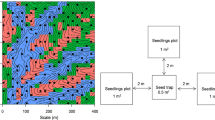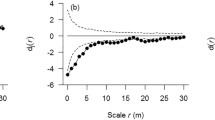Abstract
Recruitment limitation, measured by the failure of some species to arrive and establish in a site, is potentially an important process contributing to the diversity of plant communities. Limited seed production, seed dispersal, and seedling emergence due to abiotic and/or niche-dependent factors result in opportunities for less abundant species to persist. Whereas limitations affecting early phases of plant establishment are relatively well known, the less-examined limitations upon recruitment into more advanced life history stages may also contribute to the maintenance of diversity. We tested this hypothesis by decomposing recruitment limitation into seed limitation, emergence limitation (to seedlings), establishment limitation (saplings) and persistence limitation (adults) in high- and low-diversity communities. We found evidences of recruitment limitation in all ontogenetic stages, but no differences between the examined communities. Limitations in seed, seedling, saplings and adults were explained mainly by abundance in the previous stage. The negative effect of abundance of a given stage on the abundance of the next stage (negative density-dependent plant establishment) was more evident in the high diversity community. There was a reduction in species’ abundance and an increase in species richness from the seed to the adult stages, resulting in an increase in the evenness along ontogenetic stages in both communities; in all stages, the high-diversity community was richer than the low-diversity community. We found evidence that recruitment limitation operates at multiple stages and is density dependent in these two tropical forests. Our results also suggest that these effects may be stronger in the high-diversity community. Thus, recruitment limitation mediated by density dependence across multiple ontogenetic stages has to be considered in future studies of factors maintaining diversity in tropical forests.





Similar content being viewed by others
References
Augspurger CK (1983) Seed dispersal of tropical tree, Platypodium elegans, and the escape of its seedlings from fungal pathogens. J Ecol 71:759–771
Britez RM, Marques MCM (2005) Caracterização geral. Marques MCM, Britez RM (org). História natural e conservação da Ilha do Mel. Editora da UFPR, Curitiba, pp 13–17
Britez RM, Santos-Filho A, Reissmann CB, Silva SM, Athayde SF, Lima RX, Quadros RMB (1997) Nutrientes do solo de duas florestas da Planície Litorânea da Ilha do Mel, Paranaguá, PR. Rev Bras Ciê Solo 21:625–634
Calviño-Cancela M (2007) Seed and microsite limitations of recruitment and the impacts of post-dispersal seed predation at the within population level. Plant Ecol 192:35–44. doi:10.1007/s11258-006-9223-3
Clark DA, Clark DB (1984) Spacing dynamics of a tropical rain forest tree: evaluation of the Janzen–Connell model. Am Nat 124:769–788
Clark JS, Macklin E, Wood L (1998) Stages and spatial scales of recruitment limitation in Southern Appalachian forests. Ecol Monogr 68:213–235
Clark JS, Beckage B, Camill P, Cleveland B, Hillerislambers J, Lichter J, Mclachlan J, Mohan J, Wyckoff P (1999) Interpreting recruitment limitation in forests. Am J Bot 86:1–16
Clark CJ, Poulsen JR, Levey DJ, Rosenberg CW (2007) Are populations seed limited? A critique and meta-analysis of seed addition experiments. Am Nat 170:128–142
Clark CJ, Poulsen JR, Levey DJ (2013) Roles of seed and establishment limitation in determining patterns of Afrotropical tree recruitment. PLoS ONE 8:e63330. doi:10.1371/journal.pone.0063330
Colwell RK (2006) EstimateS: statistical estimation of species richness and shared species from samples. Version 8.0. User’s guide and application published at http://purl.oclc.org/estimates
Comita LS, Aguilar S, Pérez R, Lao S, Hubbell SP (2007) Patterns of woody plant species abundance and diversity in the seedling layer of a tropical forest. J Veg Sci 18:163–174
Comita LS, Muller-Landau HC, Aguilar S, Hubbell SP (2010) Asymmetric density dependence shapes species abundances in a tropical tree community. Science 329:330–332. doi:10.1126/science.1190772
Condit R, Hubbell SP, Foster RB (1992) Recruitment near conspecific adults and the maintenance of tree and shrub diversity in a neotropical forest. Am Nat 140:261–286
Connell JH (1971) On the role of natural enemies in preventing competitive exclusion in some marine animals and in rain forest trees. In: den Boer PJ, Gradwell GR (eds) Dynamics of populations. Centre for Agricultural Publishing and Documentation, Wageningen, pp 298–313
Crawley M (1990) The population dynamics of plants. Phil Trans R Soc Lond B 330:125–140
Dalling JW, Muller-Landau HC, Wright SJ, Hubbell SP (2002) Role of dispersal in the recruitment limitation of neotropical pioneer species. J Ecol 90:714–727
Eriksson O, Ehrlén J (1992) Seed and microsite limitation of recruitment in plant populations. Oecologia 91:360–364
Gilbert GS, Hubbell SR, Foster RB (1994) Density and distance-to-adult effects of a canker disease of trees in a moist tropical forest. Oecologia 98:100–108
Grubb PJ (1977) The maintenance of species-richness in plant communities: the importance of the regeneration niche. Biol Rev 52:107–145
Hardy OJ, Sonké B (2004) Spatial pattern analysis of tree species distribution in a tropical rain forest of Cameron: assessing the role of limited dispersal and niche differentiation. For Ecol Manag 197:191–202
Harms KE, Wright SJ, Calderón O, Hernández A, Herre EA (2000) Pervasive density-dependent recruitment enhances seedling diversity in a tropical forest. Nature 4004:493–495
Harper JL (1977) Population biology of plants. Academic Press, London
Herrera CM, Jordano P, López-Soria L, Amat JA (1994) Recruitment of a mast-fruiting, bird-dispersed tree: bridging frugivore activity and seedling establishment. Ecol Monogr 64:315–344
Houle G (1998) Seed dispersal and seedling recruitment of Betula alleghaniensis: spatial inconsistency in time. Ecology 79:807–818
Hubbell SP (1980) Seed predation and the coexistence of tree species in tropical forests. Oikos 35:214–229
Hubbell SP, Foster RB, O’Brien ST, Harms KE, Condit R, Wechsler B, Wright SJ, Lao SL (1999) Light-gap disturbances, recruitment limitation, and tree diversity in a neotropical forest. Science 283:554–557
Hurtt GC, Pacala SW (1995) The consequences of recruitment limitation: reconciling change, history and competitive differences between plants. J Theor Biol 176:1–12
Inman-Narah F, Ostertag R, Cordell S, Giardina CP, Nelson-Kaula K, Sack L (2013) Seedling recruitment factors in low-diversity Hawaiian wet forest: towards global comparisons among tropical forests. Ecosphere 4:1–19. doi:10.1890/ES12-00164.1
Janzen DH (1970) Herbivores and the number of tree species in tropical forests. Am Nat 940:501–528
Jordano P, Herrera CM (1995) Shuffling the offspring: uncoupling and spatial discordance of multiple stages in vertebrate seed dispersal. Ecoscience 2:230–237
Lambers JHR, Clark JS, Beckage B (2000) Density-dependent mortality and the latitudinal gradient in species diversity. Nature 417:732–735
Makana J, Thomas S (2004) Dispersal limits natural recruitment of African mahoganies. Oikos 106:67–72
Mangan SA, Schnitzer SA, Herre EA, Mack KML, Valencia MC, Sanchez EI, Bever JD (2010) Negative plant–soil feedback predicts tree-species relative abundance in a tropical forest. Nature 466:752–756. doi:10.1111/j.1365-2745.2012.01953.x
Marques MCM, Fischer E (2009) Effect of bats on seed distribution and germination of Calophyllum brasiliense (Clusiaceae). Ecotropica 15:1–6
Marques MCM, Oliveira PEAM (2008) Seasonal rhythms of seed rain and seedling emergence in two tropical rain forests in southern Brazil. Plant Biol 10:596–603. doi:10.1111/j.1438-8677.2008.00061.x
Marques MCM, Burslem D, Britez RM, Silva SM (2009) Dynamics and diversity of flooded and unflooded forests in a Brazilian Atlantic rain forest: a 16-year study. Plant Ecol Divers 2:57–64. doi:10.1080/17550870902946569
Marques MCM, Swaine MD, Liebsch D (2011) Diversity distribution and floristic differentiation of the coastal lowland vegetation: implications for the conservation of the Brazilian Atlantic forest. Biodivers Conserv 20:153–168. doi:10.1007/s10531-010-9952-4
Moore KA, Elmendorf SC (2006) Propagule versus niche limitation: untangling the mechanisms behind plant species’ distribution. Ecol Lett 9:797–804
Muller-Landau HC, Wright SJ, Calderón O, Hubbell S, Foster RB (2002) Assessing recruitment limitation: concepts, methods and case-studies from a tropical forest. In: Levey DJ, Silva WR, Galetti M (eds) Seed dispersal and frugivory: ecology, evolution and conservation. CAB International, Wallingford, pp 35–53
Münzbergová Z, Herben T (2005) Seed, dispersal, microsite, habitat and recruitment limitation: identification of terms and concepts in studies of limitations. Oecologia 145:1–8
Muscarella R, Uriarte M, Forero-Montaña J, Comita LS, Swenson NG, Thompson J, Nytch CJ, Jonckheere I, Zimmerman JK (2013) Life-history trade-offs during the seed-to-seedling transition in a subtropical wet forest community. J Ecol 101:171–182. doi:10.1111/1365-2745.12027
Nathan R, Muller-Landau HC (2000) Spatial patterns of seed dispersal, their determinants and consequences for recruitment. TREE 15:278–285
Norden N, Chave J, Belbenoit P, Caubère A, Châtelet P, Forget P-M, Riéra B, Viers J, Thébaud C (2009) Interspecific variation in seedling responses to seed limitation and habitat conditions for 14 Neotropical woody species. J Ecol 97:186–197. doi:10.1111/j.1365-2745.2008.01444.x
Norghauer JM, Newbery DM (2010) Recruitment limitation after mast-seeding in two African rain forest trees. Ecology 91:2303–2312. doi:10.1890/09-0071.1
Primack RB (1987) Relationships among flowers, fruits, and seeds. Ann Rev Ecol Syst 18:409–430
R Core Team (2012) R: A language and environment for statistical computing. R Foundation for Statistical Computing, Vienna, AT. (http://www.R-project.org/)
Ribbens E, Silander JA, Pacala S (1994) Seedling recruitment in forests: calibrating models to predict patterns of tree seedling dispersion. Ecology 75:1794–1806
Scarano FR (2002) Structure, function and floristic relationships of plant communities in stressful habitats marginal to Brazilian Atlantic forest. Ann Bot 90:517–524
Schupp EW (1992) The Janzen–Connel model for tropical tree diversity: population implications and the importance of spatial scale. Am Nat 140:526–530
Schupp E, Fuentes M (1995) Spatial patterns of seed dispersal and the unification of plant population ecology. Ecoscience 2:267–275
Schupp EW, Milleron T, Russo SE (2002) Dissemination limitation and the origin and maintenance of species-rich tropical forest. In: Levey DJ, Silva WR, Galetti M (eds) Seed dispersal and frugivory: ecology, evolution, and conservation. CAB Publishing, Wallingford, pp 19–33
Silva S (1998) As formações vegetais da Planície Litorânea da Ilha do Mel, Paranaguá-PR, principais características florísticas e estruturais. PhD Thesis, Universidade Estadual de Campinas, Campinas, Brazil
Svenning JC, Wright SJ (2005) Seed limitation in a Panamian forest. J Ecol 93:853–862
Tilman D (1994) Competition and biodiversity in spatially structured habitats. Ecology 75:2–16
Turnbull LA, Crawley MJ, Rees M (2000) Are plant populations seed-limited? A review of seed sowing experiments. Oikos 88:225–238
Verheyen K, Hermy M (2001) The relative importance of dispersal limitation of vascular plants in secondary forest succession in Muizen Forest, Belgium. J Ecol 89:829–840
Webb CO, Peart DR (1999) Seedling density dependence promotes coexistence of Bornean rain forest trees. Ecology 80:2006–2017
Webb CO, Peart DR (2001) High seed dispersal rates in faunally intact tropical rain forest: theoretical and conservation implications. Ecol Lett 4:491–499
Wehncke EV, Hubbell SP, Foster RB, Dalling JW (2003) Seed dispersal patterns produced by white-faced monkeys: implications for the dispersal limitation of neotropical tree species. J Ecol 91:677–685
Wenny DG, Levey DJ (1998) Directed seed dispersal by bellbirds in a tropical cloud forest. Proc Nat Acad Sci 95:6204–6207
Wills C, Condit R, Foster RB, Hubbell SP (1997) Strong density- and diversity-related effects help to maintain tree species diversity in a neotropical forest. Proc Nat Acad Sci 94:1252–1257
Wright SJ (2002) Plant diversity in tropical forests: a review of mechanisms of species coexistence. Oecologia 130:1–14
Zobel M, Otsus M, Liira J, Moora M, Mols T (2000) Is small scale species richness limited by seed availability or microsite availability? Ecology 81:3274–3282
Acknowledgments
We are thankful to Renato Henriques-Silva and Pedro H. P. Braga for their help with null model, to all of the students from the Laboratory of Plant Ecology who helped in the field work, to Parana State Environmental Institute (IAP), for allowing work in Ilha do Mel, to the Brazilian Education Council (CAPES) for sponsoring the stay of M.C.M.M. at the University of Aberdeen during her sabbatical leave, and to the Brazilian Research Council (CNPq) for the Grants to M.C.M.M (CNPq 304650/2012-9 and 229349-2013-7).
Author information
Authors and Affiliations
Corresponding author
Additional information
Communicated by Joy Nystrom Mast.
Electronic supplementary material
Below is the link to the electronic supplementary material.
Rights and permissions
About this article
Cite this article
Marques, M.C.M., Burslem, D.F.R.P. Multiple stage recruitment limitation and density dependence effects in two tropical forests. Plant Ecol 216, 1243–1255 (2015). https://doi.org/10.1007/s11258-015-0505-5
Received:
Accepted:
Published:
Issue Date:
DOI: https://doi.org/10.1007/s11258-015-0505-5




